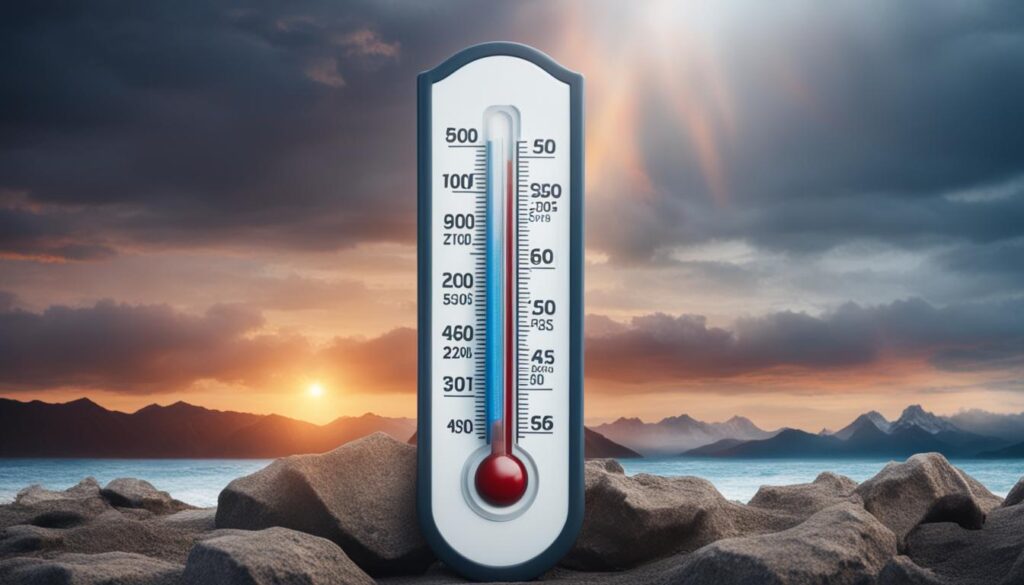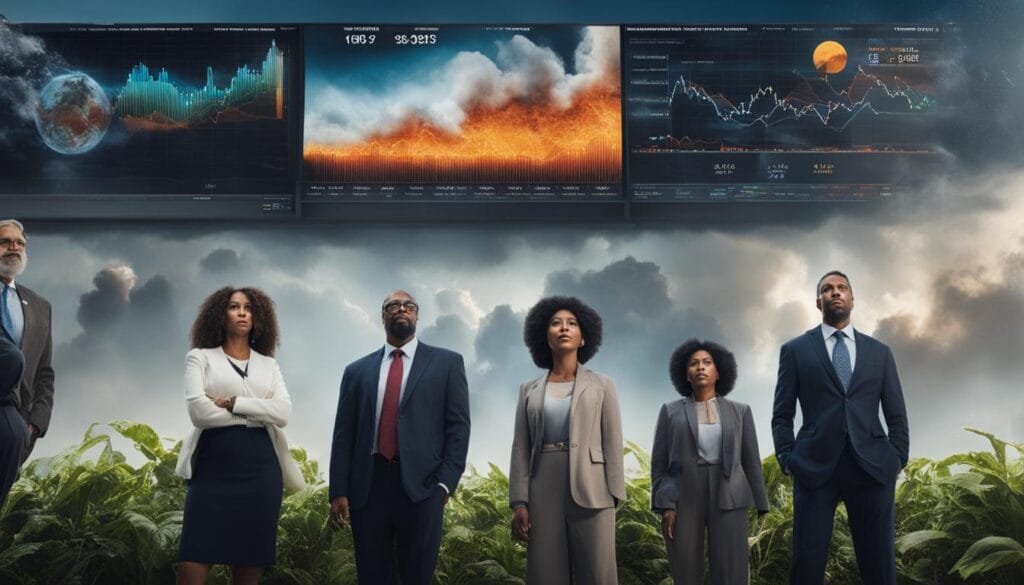A study conducted by researchers at the University of East Anglia and the University of Cambridge has revealed the potential impact of climate change on sovereign credit ratings. The findings highlight the critical connection between climate change and credit scores, shedding light on the environmental risks that could affect credit rating climate risk in the near future. Understanding the implications of climate change on your credit rating is imperative for individuals and financial institutions alike.
Key Takeaways:
- Climate change could lead to a drop in credit ratings for 59 nations by 2030.
- Failure to reduce emissions may result in an average downgrade of 2.18 notches for 81 nations by the end of the century.
- Climate-related risks can increase borrowing costs and corporate debt.
- Financial assets and liabilities are vulnerable to climate-related physical and transition risks.
- The private sector is incorporating climate-related factors into credit assessments, creating eco-credit scores.
The Link Between Climate Change and Financial Health
Climate change not only affects the environment but also has implications for financial health. The study mentioned earlier highlights the potential for increased costs of borrowing and higher costs of corporate debt due to climate change. Furthermore, climate-related risks, such as physical risks (e.g., extreme weather events) and transition risks (e.g., policy changes to promote a low-carbon economy), can impact the value of financial assets and liabilities. These risks could lead to a destabilizing effect on the financial system, causing a reduction in bank lending and insurance provision. It is crucial for individuals and financial institutions to be aware of and manage these climate-related risks to maintain their credit health.
The Impact on Credit Health
As climate change continues to worsen, the financial health of individuals and businesses could be significantly affected. The increased frequency and intensity of natural disasters can lead to property damage, which can impact individuals’ ability to repay loans and meet financial obligations. This can result in lower credit scores and limited access to credit. Additionally, the transition to a low-carbon economy may lead to job losses in certain industries, potentially causing income disruptions and financial strain for individuals and their families.
Quote: “Climate change poses a significant threat to financial health. It is essential for individuals and organizations to take proactive measures to mitigate the risks and ensure long-term financial stability.” – [Name], Financial Analyst
Financial institutions also face risks associated with climate change. These risks include the devaluation of assets in sectors heavily dependent on fossil fuels, such as coal and oil. As governments implement policies to reduce greenhouse gas emissions, these sectors may experience significant declines in value, leading to potential losses for financial institutions that hold investments in these industries. Therefore, financial institutions must consider climate-related risks in their lending and investment decisions to safeguard their own financial health.
The Need for Climate Risk Management
Given the impact of climate change on financial health, it is crucial for individuals, businesses, and financial institutions to implement effective climate risk management strategies. This includes conducting comprehensive risk assessments, identifying vulnerabilities, and developing plans to mitigate and adapt to climate-related risks. Financial institutions should also incorporate climate risk factors into their credit assessments to gain a more accurate understanding of borrowers’ creditworthiness. By taking proactive measures to address climate-related risks, individuals and organizations can better protect their financial health in the face of changing climatic conditions.
| Climate Change Risks | Implications for Financial Health |
|---|---|
| Increasing frequency and intensity of natural disasters | Potential property damage and lower credit scores |
| Transition to a low-carbon economy | Job losses in certain industries and income disruptions |
| Devaluation of assets in fossil fuel-dependent sectors | Potential losses for financial institutions |
| Policy changes to promote a low-carbon economy | Potential reduction in bank lending and insurance provision |
Private Sector’s Response to Climate-Related Risks
The increasing recognition of climate-related risks has prompted the private sector to take proactive measures to address these challenges. One significant way in which the private sector is responding to climate-related risks is through the adaptation of credit scoring systems. Financial institutions are acknowledging the importance of considering a borrower’s environmental impact when assessing creditworthiness, and as a result, they are developing eco-credit scores.
Eco-credit scores take into account the borrower’s sustainability practices and their alignment with the goals of a low-carbon economy. By incorporating climate risk into credit assessments, financial institutions can better evaluate the creditworthiness of individuals and businesses in the context of climate change. This approach incentivizes sustainable practices and supports the transition to a more environmentally conscious future.
The integration of climate risk into credit scoring systems is a proactive step that promotes environmental responsibility while also safeguarding the financial sector. It encourages borrowers to make environmentally conscious choices and align their practices with sustainable objectives. Ultimately, this contributes to the overall resilience of the financial system in the face of climate-related challenges.
Example Table: Credit Score Adaptation
| Financial Institution | Eco-Credit Score | Environmental Factors Considered |
|---|---|---|
| ABC Bank | A | Investments in renewable energy projects |
| XYZ Credit Union | B+ | Green building initiatives and sustainable practices |
| DEF Finance | A- | Reduction of greenhouse gas emissions |
Table: Example of Financial Institutions Incorporating Climate Risk into Credit Scoring Systems

The Role of Climate Risk Modelers
Climate risk modelers play a crucial role in assessing and quantifying the impact of climate change on financial stability. These experts provide valuable guidance on both physical risks, such as exposure to hazards like extreme weather events, and transition risks, which are changes related to the transition to a low-carbon economy. Their insights are relied upon by financial institutions, regulators, and credit rating agencies to make informed decisions.
By incorporating the latest climate science and data, climate risk modelers can provide reliable assessments of climate-related risks. These assessments help identify potential vulnerabilities in the financial system and inform risk management strategies. For example, modelers can analyze the potential impact of rising sea levels on coastal properties or the financial implications of shifting policies to reduce greenhouse gas emissions.
However, it is important to note that the quality and accuracy of climate risk models can vary. The field of climate modeling is still evolving, and there are ongoing efforts to improve the robustness and consistency of these models. Collaboration between climate scientists, economists, and statisticians is crucial to ensure that models accurately capture the complex dynamics of climate change and its impact on financial markets.
The Role of Climate Risk Modelers
Climate risk modelers are experts who assess and quantify the impact of climate change on financial stability. They provide guidance on both physical and transition risks, helping financial institutions, regulators, and credit rating agencies make informed decisions. These modelers play a crucial role in identifying vulnerabilities in the financial system and informing risk management strategies.
Climate risk modelers incorporate the latest climate science and data into their assessments. By analyzing various scenarios, they can estimate the potential financial impact of climate-related events, such as extreme weather events or policy changes related to the transition to a low-carbon economy. However, it is important to acknowledge that climate risk models are not infallible and that there is ongoing work to improve their accuracy and consistency.
Collaboration between experts in climate science, economics, and statistics is vital to ensure that climate risk models effectively capture the complex dynamics of climate change. By continuously refining and enhancing these models, we can better understand and manage the financial risks associated with climate change.
| Benefits of Climate Risk Models | Challenges of Climate Risk Models |
|---|---|
| 1. Identify potential vulnerabilities in the financial system | 1. Variability and uncertainty of climate projections |
| 2. Inform risk management strategies | 2. Lack of historical data on climate-related events |
| 3. Estimate financial impact of climate-related events | 3. Integration of climate models with financial models |
| 4. Provide insights for policymakers | 4. Limited understanding of complex interactions between climate and economy |
Conclusion
Climate change poses significant risks to credit scores and overall financial health, both at the individual and systemic levels. The research conducted by the University of East Anglia and the University of Cambridge highlights the potential for higher borrowing costs and increased corporate debt expenses due to climate-related factors. These risks can have a destabilizing effect on the financial system, leading to reduced bank lending and insurance provision.
To ensure long-term resilience in the face of climate change, it is crucial for individuals, financial institutions, and regulators to recognize and address these risks. Incorporating climate risk assessments into credit scoring systems can provide a more comprehensive understanding of a borrower’s creditworthiness. Additionally, promoting sustainable practices through the use of eco-credit scores can incentivize environmentally responsible behavior and support the transition to a low-carbon economy.
Climate risk modelers play a vital role in quantifying and assessing the impact of climate change on financial stability. However, the quality and accuracy of these models vary, and it is essential for them to incorporate the latest climate science and data. By continually improving these models, financial institutions, regulators, and credit rating agencies can make more informed decisions and effectively manage climate-related risks.
Overall, addressing the financial impact of climate change requires collaboration and proactive measures. By recognizing the interplay between climate and finance, we can navigate the challenges and opportunities presented by climate change while safeguarding our financial health.
FAQ
How does climate change impact credit ratings?
Climate change can have a significant impact on credit ratings. Without emissions reduction, 59 nations could experience a drop in their credit rating by 2030. This drop in credit rating could lead to higher costs of borrowing for nations, which in turn would translate into higher costs of corporate debt.
What are the risks of climate change on financial health?
Climate-related risks, such as physical risks (e.g., extreme weather events) and transition risks (e.g., policy changes to promote a low-carbon economy), can impact the value of financial assets and liabilities. These risks could lead to a destabilizing effect on the financial system, causing a reduction in bank lending and insurance provision.
What steps are the private sector taking to mitigate climate-related risks?
The private sector has started incorporating climate-related factors into their credit assessments. Some financial institutions are creating eco-credit scores that consider a borrower’s environmental impact. This approach aims to incentivize sustainable practices and support the transition to a low-carbon economy.
What role do climate risk modelers play in assessing climate-related risks?
Climate risk modelers provide guidance on both physical risks (exposure to hazards) and transition risks (changes related to a low-carbon economy). Financial institutions, regulators, and credit rating agencies rely on the insights provided by climate risk modelers to make informed decisions.
How can individuals and financial institutions address climate-related risks?
It is important for individuals and financial institutions to be aware of and manage climate-related risks. By incorporating climate risk assessments into credit scoring systems and promoting sustainable practices, both individuals and financial institutions can navigate the challenges and opportunities presented by climate change while safeguarding their financial health.


Pingback: Every Cent Counts: How Daily Spending is Affected by Climate Change! – Straight Fire Money